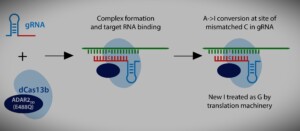In this blog post, AI is used to give a general knowledge about RNA editing. RNA editing, also known as RNA modification, is a molecular process through which some cells can make discrete changes to specific nucleotide sequences within an RNA molecule after it has been transcribed from DNA by RNA polymerase. RNA editing has been observed in different types of RNA, such as mRNA, tRNA, rRNA, and miRNA, and in different organisms, ranging from prokaryotes to eukaryotes and their viruses.
Types of RNA editing
There are two main types of RNA editing: substitution/modification editing and insertion/deletion editing. Substitution/modification editing involves the chemical alteration of individual nucleotides, such as methylation or deamination. Nucleotide deamination converts adenosine (A) to inosine (I) or cytosine (C) to uracil (U). Insertion/deletion editing involves the addition or removal of nucleotides in the RNA.
Enzymes used
RNA editing is catalyzed by various enzymes, such as adenosine deaminases acting on RNA (ADARs), cytidine deaminases acting on RNA (CDARs), and pseudouridine synthases. These enzymes recognize specific sequences or structures in the RNA and perform the editing reactions.
Implications of RNA editing
RNA editing is a post-transcriptional process that alters the nucleotide sequence of RNA molecules, resulting in changes in the information content and function of RNA. RNA editing can affect the coding or non-coding regions of RNA. It can create diversity in the transcriptome and proteome, enabling cells to adapt to different environmental conditions and stimuli.
RNA editing can occur in different types of RNA, such as messenger RNA (mRNA), transfer RNA (tRNA), ribosomal RNA (rRNA), microRNA (miRNA), and long non-coding RNA (lncRNA). RNA editing can affect the expression and regulation of genes, the translation and folding of proteins, the splicing and stability of RNA, and the interactions between RNA and other molecules.
RNA editing can affect various aspects of gene expression, such as protein coding, splicing, stability, localization, and interactions of RNA. It is involved in various biological processes, such as immune system regulation, viral defense, neuronal development, and adaptation to environmental stress.
RNA editing is essential for normal development and function of many organisms, from bacteria to humans. It can be influenced by environmental factors, such as temperature, stress, diet, and drugs.
RNA editing has been implicated in various human diseases, such as cancer and neurological disorders, where it can alter the expression and function of genes involved in immune response, cell proliferation, differentiation, migration, and apoptosis. It is therefore an important mechanism that modulates the diversity and complexity of RNA molecules and their roles in human health and disease.
Therapeutic RNA Editing
Therapeutic RNA editing is an emerging field that aims to harness the power of RNA editing for the treatment of various diseases, such as genetic disorders, cancers, viral infections, and neurodegenerative diseases. It can be achieved by either enhancing or inhibiting the endogenous RNA editing machinery, or by introducing exogenous RNA editing enzymes or guide RNAs.

Therapeutic RNA editing has several advantages over other gene therapy approaches, such as high specificity, reversibility, and versatility. It can potentially overcome some of the limitations of conventional gene therapy, such as immunogenicity, off-target effects, and integration into the host genome. However, therapeutic RNA editing also faces several challenges, such as delivery, safety, efficiency, and regulation. It still may offer a novel and versatile approach for modulating gene expression and function in a precise and controlled manner.
Conclusion
RNA editing is a fascinating and complex phenomenon that has been studied for decades. However, there are still many unanswered questions and challenges in this field. For example, how is RNA editing regulated and coordinated with other processes in the cell? How does RNA editing affect the evolution and diversity of life? How can we exploit RNA editing for therapeutic purposes? These are some of the topics that researchers are currently investigating and exploring.
See also: